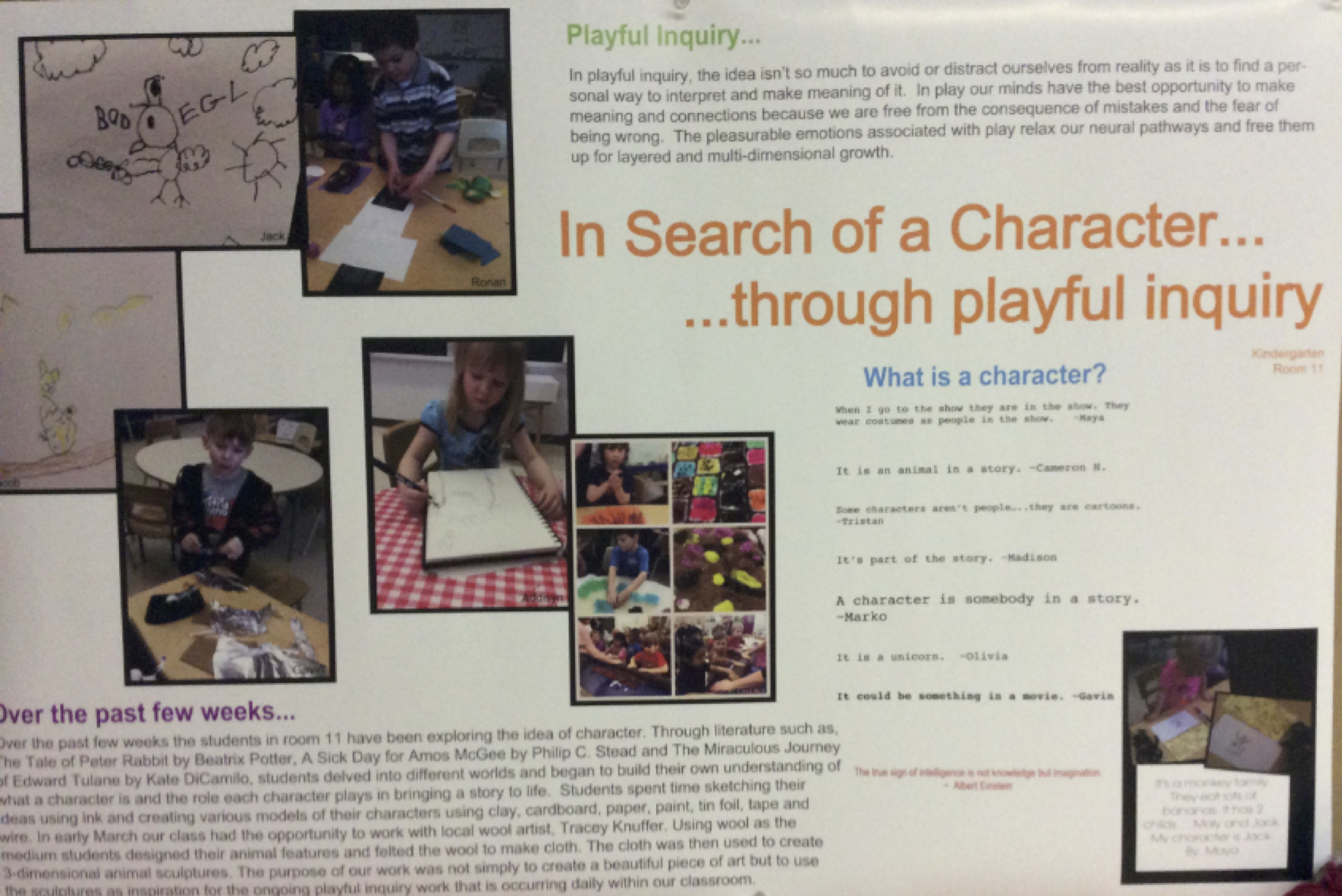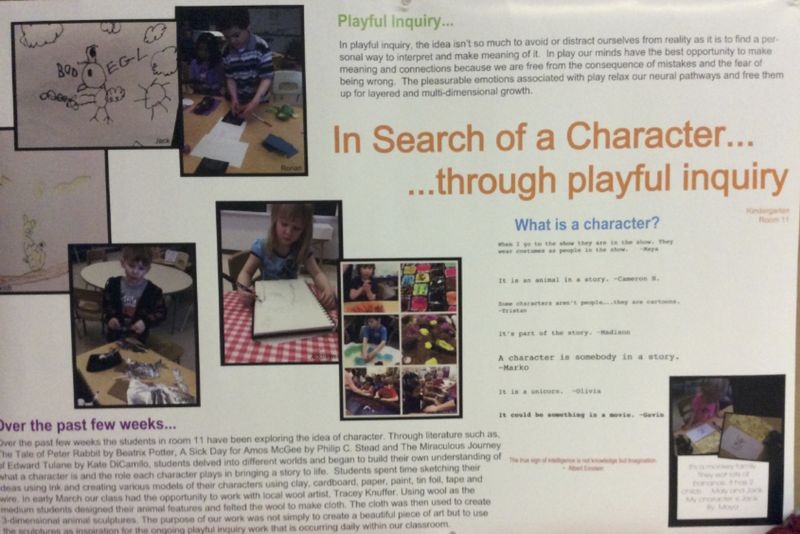Guest Post: Becoming a Teacher-Researcher

Today’s guest post comes from Sandra Patton, a teacher at Maple Ridge School in Alberta and member of last year’s Opal School Mentorship Program.
A year ago I was introduced to Opal School through a small workshop in Calgary, AB. Shortly after hearing about the school I applied for and received admission to their Mentorship Program; a year long, multi-visit program that allows for observations and a variety of workshop opportunities. At the time I knew little about the school, it’s program, or how my experiences there would greatly shift my thinking and teaching practice.
The first thing that struck me upon entering Opal classrooms was the physical space and how inviting it was based on the set up and the different forms of media present. It was obvious that students had many opportunities to express themselves and their thinking in a variety of ways. Something else that struck me, after making observations of the school and the teachers, was the role of language. How the teachers and students communicated with each other was very different than most classrooms I had observed or been apart of, including my own. As with the purposeful set up of the physical space, the teacher’s language was also very purposeful.
It was these initial observations that inspired my thinking around the following question, “How can my use of purposeful language and documentation support students’ playful inquiry and story telling skills?” This was a slightly daunting task as I had never viewed myself as a teacher researcher before led alone developed a specific research question to explore. I asked myself,
“What is a teacher-researcher?”
“Why do I want/ feel the need to see myself as a researcher?”
“How would being a teacher-researcher impact my practice?”
Over the past eight months my use of language and how I communicate to my students has shifted. In reading Peter Jonhston’s books, Choice Words and Opening Minds, I have developed a better understanding of the subtlety of language. Opal School gave me the opportunity to see the theory of this language used in a practical setting within their classrooms. Focusing my attention to process feedback, (ie. I noticed you used the colour red here, what made you choose red?), rather than personal feedback, (ie. You did a great job!), was hard. This type of language took effort and the shift was gradual. I started with just asking deeper level questions like WHY and HOW. Beyond that I was asking things like, “Tell me more about….” Or “What is your story….” Or “I noticed you did….can you tell me about it?” I also started posting more questions throughout my classroom in order to introduce and encourage students to ask more questions themselves. We used a number of thinking routines from, Making Thinking Visible by Ritchart, Church and Morrison, to further develop risk-taking, questioning and metacognition skills. In particular, the See, Think, Wonder, routine was used three times throughout the year. This routine involved showing the students a picture and asking them to start by only commenting on what they could see. After that they were asked to only comment on what it made them think about. The last part, and by far the most challenging, involved asking them what the picture made them wonder about. By the end of April students were sharing their thinking and wondering outside of a structured routine about a number of things in our classroom: our butterfly inquiry, story writing and literature.
I think stories are the imaginations in your head. ~Nate
I wonder what happens in that chrysalis? ~Jack
How does the caterpillar turn into a butterfly? ~Cace
I wonder what butterfly wings are made out of? ~Addisyn
After reading a chapter from The Miraculous Journey of Edward Tulane by Kate Di Camilo, students commented…
I think Edward is dreaming….it’s a living dream. ~Simon
Maybe he is becoming an angel. He wants to go to heaven and be with Sarah Ruth. ~Abby
As the students and I developed our language skills together we were also building deeper relationships with each other. Respectful, purposeful language made a tremendous impact to the community culture within my classroom. Currently, I am seeing less extreme behaviours and an increase in positive peer interactions.
The second part of my research question centered around documentation. In the past I have made attempts to document student learning by taking photos of student work, the process and recordings of students voice. It wasn’t until this year that I developed a deeper understanding of documentation. During one of the workshops at Opal School, Mara Krechevsky and Ben Mardell shared some of their thinking and reminded me that documentation includes not only observing and recording but also interpreting and sharing. This gentle nudge encouraged me to think more deeply about who I am creating my documentation for….students, parents, colleagues….and what should I do with the documentation once it’s done. How does my documentation further the learning that is occurring in my classroom?
In December I created a documentation panel around the students’ early work with our version of Story Workshop. In March I created a second panel based on the students’ work with creating characters to inspire their playful inquiry. In both cases, I wanted to communicate the theories behind these activities to colleagues and parents. I used this tool to show that these processes were not just one time activities rather they were examples of long term, inquiry work.
I created this display with the documentation panel, student drawing and stuffed characters for our parent evening in March. The stuffed characters were up for only one night as the students insisted they play with them the following day.

It has been our work with character development that has made the greatest impact on my teaching practice and student learning this year. Over the past few years I have observed a decline in imaginative play with the groups of children coming into my classroom. Often their play revolved around movie or video game characters, which in turn limited their storylines and ideas. In February, I invited a wool artist into the class to felt wool with the children and build stuffy characters. Students had spent time developing their character ideas in the weeks previous and were further inspired to add additional details once working with the medium of wool. Magically their characters were coming to life. Since March, students have played with their characters on a daily basis. They have spent time building homes, creating stories and writing books about these little stuffed animals. I have seen an increase in oral language development, cooperative peer play and engagement for all students.
In order to document beyond photos, quotes and drawings I decided to interview each child as they described their characters. I felt it was important for me to document and highlight the oral language skills of each student individually. At this age students’ strong oral language skills far outweigh their ability to record stories in print. I wanted the students to know that their voice, (oral language), was being recognized as valued and important while also having the opportunity to push my own documenting skills by using a new, (to me), piece of technology. These videos were then uploaded to a private YouTube account, which was linked with a unique QR code.
Each year our school hosts a Celebration of Learning event where parents are invited to come into the classroom and share in the learning that has occurred throughout the year. These videos allowed students to share the thinking and ideas that went into the development of their characters. Parents were able to scan their child’s QR code and watch their child’s video on their phone. During this time I made my second documentation panel present in order for parents to gain a better understanding of the overall process and the reasons behind why the students had
created these stuffed characters.
As mentioned, the primary audience for my documentation throughout the year has been the parents of the students I teach. Through daily parent blogs and my documentation panels I was able to communicate to parents the what, where, why’s and how’s behind what was going on in their child’s classroom; particularly when it looks so different from what they might expect. Recently, my principal asked if I will do this activity again next year…… I told her that I rarely do the same thing twice and that this character development work came from the students’ interest in story telling and recording. This journey to develop a better understanding of teacher as researcher, the role of language, documentation and environment has helped me to support the oral language development and positive peer play within my classroom. I wonder how my use of purposeful language and documentation will influence my practice next year……

